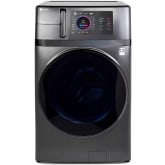Written by David Kender, editor in chief with 15+ years testing every kind of consumer product.
October 6, 2025
All-in-one washer-dryer combos are a dream solution for people with limited space for in-home laundry. But for decades, the reality fell far short of expectations: Tiny capacities, 4-6 cycle times, and a 240V outlet requirement. Times have finally changed. There are several great combo washer-dryers on the market, including two of our favorites, the GE Profile UltraFast (model PFQ97HSPVDS) and the LG WashCombo (model WM6998HBA). Let’s see how these two laundry room titans stack up against each other.
Cycle Time - Winner: GE Profile PFQ97HSPVDS
If you’re shopping for washer-dryer combos and have some preconceptions about their historical weak points, cycle times are probably topping the list of concerns. Yes, the convenience of a product that doesn’t require you to transfer 20 pounds of wet clothing into a dryer is undeniable, but washer-dryer combos are trying to shake a bad reputation for total cycle times that could take nearly half a day. Thankfully, the latest batch of combo washer-dryers is far faster, though we know that every minute saved is a minute you can be doing something more enjoyable with your time.
Overall, the GE Profile’s time for a complete washing and drying cycle was 85 minutes in Quick mode and about 2 hours in Normal mode—on par with the average cycle times for separate washers and dryers.
The LG WashCombo lagged behind with an average wash-and-dry cycle time of 142 minutes. The dryer cycle, in particular, was slower than we’d like. This may not be an issue for people who run their dryer overnight, but it means that the GE Profile is the clear winner.
Both machines were excellent at removing stains in our lab testing. They performed practically identically in normal and quick-clean cycles. The LG was a little more effective at stain removal in heavy cycles, and the GE had an edge in handling your delicates with the light touch they need.
Overall, the LG WashCombo won the day with our cleaning performance tests, but the difference was marginal.
The biggest difference between washer-dryer combos and traditional dryers is the venting. Traditional dryers vent hot, humid air through a duct to the outside of your house. The GE Profile Washer Dryer Combo, the LG WashCombo, and some other combo washer-dryers work a different way. Instead, they use an ultra-energy-efficient heat pump to remove moisture from clothes via condensation. The excess water drains out the same outgoing pipe that the wash cycle drainage uses.
Getting perfectly dry clothes is sometimes a challenge with these types of machines. And in this case, both machines fell a bit flat, just in different ways. The GE’s dry cycle time was faster, but some items, especially bulky jeans and jackets, were still damp when we took them out. We had to select the More Dry function to give it additional time. Ultimately, this is a failure of the GE’s sensors in the drum to properly assess the remaining moisture content.
The LG didn’t have the same problems with accuracy, but all dry cycle times were considerably longer than the GE.
Capacity - Winner: LG WM6998HBA
Both of these machines provide generous washing capacity, especially when you compare them to the combo units of yore. The capacities are, in fact, on par with many of the most popular standard front-load washers.
The GE Profile offers 4.8 cubic feet of drum space, while the LG WashCombo just bests it at 5.0 cubic feet. The difference is negligible, but the LG wins here. Practically speaking, you can fit a large load in both machines, including bulky bedding.
Physical Size - Winner: LG WM6998HBA
Chances are, if you’re shopping for a combo washer-dryer, you’re limited on space. A compact, single device that washes and dries is a perfect solution for people who would rather give up a bit of precious floor space rather than trudge out to the laundromat.
The GE Profile PFQ97HSPVDS measures 46-7/10th inches x 28 inches x 32 inches (H x W x D). While nowhere near as high as a stacked washer and dryer unit, it’s notably several inches taller than an average standalone washing machine. It will not fit under counters.
The LG WM6998HBA measures 39 inches x 27 inches x 33 -1/8th inches (H x W x D). That’s much shorter than the GE. But note that the LG requires 4 inches of clearance between the back of the unit and the wall. So effectively, it’s around 38 inches deep—considerably deeper than the GE.
Both units are far smaller than a paired washer and dryer set. Purely in terms of cubic volume, the LG WashCombo is smaller, but you’ll want to measure carefully before you make your purchase. The real winner here will be whichever option fits your home’s intended space.
Energy Efficiency - Winner: LG WM6998HBA
Cost savings from energy efficiency gains are one of the big marketing points around heat pump technology. And it’s true that heat pumps eat up far less energy than traditional dryers—as much as 4x less. But the fact is that energy is fairly cheap in America, especially when compared to Europe, where washer-dryer combos are more common. Yes, you’ll save some money, but be realistic about how much this should impact your decision. The more loads of laundry you do, the more money you save (comparatively), but your payback timeline could be several years.
That said, the LG WM6998HBA WashCombo is more energy efficient than the GE Profile Washer Dryer Combo. According to their Energy Star ratings, the LG uses 479 kWhr/year. The GE uses 535 kWhr/year. In Reviewed’s home state of Massachusetts, that only amounts to a few bucks difference (between $125 - $139 per year).
One other cost consideration related to energy efficiency is tax credits. Many states offer credits for investments in green residential investments like heat pumps. Be aware, however, that many federal tax credit programs related to clean energy are expiring at the end of 2025.
Warranty and Reliability - Winner: LG WM6998HBA
LG has a proven track record in front-load washers. They come up higher in reliability scores across the internet, at least in this particular category. We love and recommend many GE products, so we think you’d also be happy with the GE Profile PFQ97HSPVDS in the long term, but the reliability numbers back LG as the winner.
In terms of warranty, the LG WM6998HBA offers a one-year warranty for standard parts and labor, and a 10-year warranty on the direct-drive motor (labor not included). Direct-drive motors are generally more reliable than belt-driven motors, which can stretch and wear out over time. The stainless-steel drum—which gets twice the usage when it’s a washer-dryer combo unit—has a three-year parts warranty from the date of purchase.
The GE Profile PFQ97HSPVDS comes with a one-year warranty for parts and labor, just like the LG. It also has a five-year, parts-only warranty on the sealed heat pump drying system and a ten-year, parts-only warranty on the motor.
Overall - Winner: LG WM6998HBA
The LG WM6998HBA Smart Front Load Washer Dryer Combo is our recommendation over the GE Profile PFQ97HSPVDS Ventless All-In-One. LG has a well-earned reputation for reliability, and the WM6998HBA offers better wash performance, a longer warranty, and is slightly more compact.
But it’s not a lop-sided competition; the GE Profile may still be better for some people. You’ll be happy buying the GE Profile if speedy wash-dry cycles are your top priority. And while taller, the GE’s body isn’t as deep, so it may be a matter of what actually fits in your home. We also just really liked the GE. They’re both good machines, and both so much better than washer-dryer combos that came before them.
Read More About Washing Machines and Laundry on Reviewed
The Best Washer Dryer Combos: This is our complete roundup of all the top-perfoming washer-dryer combos on the market, including GE, Samsung, and LG.
Everything you need to know about ventless dryers: If your home doesn’t have a way to vent a traditional dryer, you still have options. This piece explains how ventless dryers operate and why they might be a smart solution for your space.
The Best Compact Washers: When space is limited, a compact washer can be the perfect fit. This guide breaks down the advantages and trade-offs of smaller machines and highlights the best models available.
The Best Laundry Centers We've Tested: Step beyond a standard stacked washer and dryer with these integrated laundry towers—coordinated systems that combine both appliances into one streamlined unit with shared controls for seamless performance.
The Best Front-Load Washers We’ve Tested: Whether you’re shopping for a standalone front-loader, a stackable pair, or a full laundry center, this roundup identifies the top-performing front-load washing machines for every setup.
Hot dryers may be damaging your clothes—here's what to do: Learn what temperature your dryer should reach, why excessive heat can harm fabrics, and how to fix the problem if your dryer is running too hot.
Not Normal—7 other laundry settings and when to use them: Modern washers include a variety of cycles beyond “Normal.” This article explains what each one does and how to choose the right setting to clean your clothes more effectively.





 4.2
4.2




